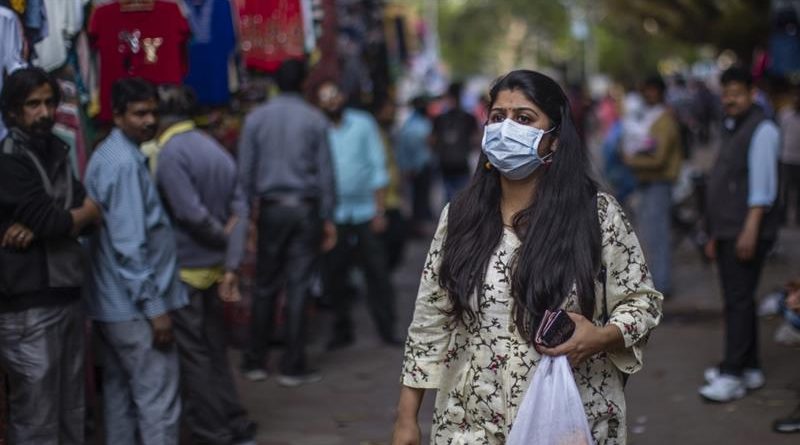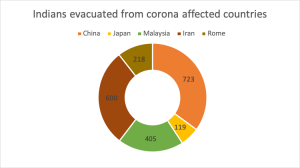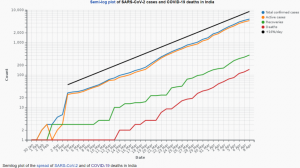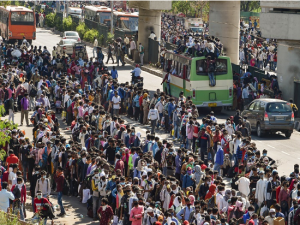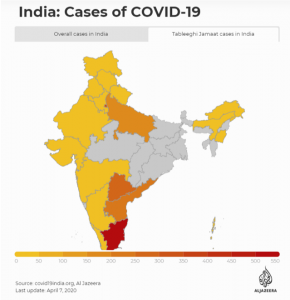An empirical assesement of India’s position in handling COVID 19: Prospects and Challenges
Introduction:
The dawn of 2020 will be remembered as the year of loss of millions of lives by a coronavirus, shrinking economies, the retreat of state’s sovereignty, decline in US hegemony and consequently the revamping of New World Order. The reason for those upheavals is the denouement in the outbreak of COVID 19¬: an infectious disease caused by severe acute respiratory syndrome coronavirus 2 (Nanshan Chen*). It started from the capital city of Hubei province of China, which over a period of time took shape as the global pandemic and subsequently became the foremost priority of all countries to get control of its dissemination. Countries like Italy, Iran, Spain, France and the United States couldn’t take the cautious note of its consequences and failed to save their millions of citizens from it. In the globalized world, the major reason for its quick outbreak and the failure of those respective governments was the ‘widespread movement of people’. The coming into contact with the person contaminated with corona led to the chain of the ensuing flow of virus in the countries. Therefore, nations with the larger population and density are more prone to its dissemination and therefore, a country like India, which shares a land boundary of approximately 3500 km with China was anticipated to inconceivable ramifications (Ministry of Home Affairs). However, India was out of the league and exceptionally handled this emergency, without affecting the normal course of business and maintained the status quo.
Characterizing India’s Strategic Health Model:
India was constantly monitoring the overwhelming upsurge of cases in China and took abundant precautions in the form of assessing the arrangements provided in case burgeoning of positive cases. On 22nd January, Ministry of Health and Family Welfare took various measures of meeting with important health officials of provinces and centre, facilitating thermal screening at ports and airports of New Delhi, Mumbai, Chennai, Kolkata due to their heavy international traffic, establishing Joint Monitoring Group to assess the preparedness and response to be taken if cases went up significantly, taking stock of medical equipment and others (Bureau, 2020). It was followed up by chairing the high-level meeting at the helm of Principal Secretary to Prime Minister, Health Secretary and Cabinet Secretary. Then the preparedness has been tested on 2nd February where one positive case has been reported from Kerala (Bureau). In the wake of it, the matter has been taken up in the highest legislative body where government addressed, from 17th February onwards all existing visas were become void and latter advised all to refrain from visiting China (ibid, 2020). Not just resident Indians, but its diaspora is also the priority to be taken care of as diaspora is the strategic asset in India’s outreach to foreign nations and the key component in its foreign policy. Moreover, the government was closely monitoring the situations of Indian diaspora stranded in affected countries and started evacuating them from all the affected countries. The below diagram illustrates the total evacuation done by the government so far (ibid):
Source: Data from Press Information Bureau till 9th March 2020
With the evacuation process undergoing and stranded citizens were initially put in certain makeshift quarantine facilities at military bases. There was a dire need for ample quarantine facilities to cater to the local requirement in the near future. Under this backdrop, Minister of Health, Dr Harsh Vardhan has facilitated a meeting with private hospitals of North Capital Region to engage them in the fight against COVID 19. He stated, “It is time for public & private sectors to come together and work as an alliance for collective efforts towards COVID-19 management” (ibid). Meanwhile, the cases started increasing with the slow growth rate and to counter it Prime Minister chaired many significant meetings with various stakeholders of the Ministry of Health, Defence, Civil Aviation, Home and External Affairs. While evacuating the Indians, its air force has also extended help to neighbouring countries in evacuating latter citizens too. This praxis of soft power in this hardship has helped India in enduring its perception of ‘big brother’ in the region. On 13th March, it has been followed by an initiative of Indian Prime Minister by video conferencing with SAARC nations: regional association of countries of South Asia, to chalk out a strategy to fight coronavirus (Bhattacherjee, 2020). Experts of the region view it as step-in furtherance to strengthen its regional ties and the manifestation of ‘Neighbourhood First Policy’.
Another major step has been taken by Prime Minister Narendra Modi in the light of rising cases and an attempt to break the quick dissemination of the virus. On 22nd March, he called for “People’s Curfew”. It means a curfew imposed by the people, for the people and on the people themselves. He further illustrated that during the imposition of curfew all people stay in their homes and won’t roam around their localities from 7 AM to 9 PM. In this curfew, only people associated with emergency and essential services are exempted (Bureau). The countrywide lockdown has been endorsed by the World Health Organization’s Envoy. He propounded that decision was quick and taken much before the situation getting worse and undoubtedly the decision is courageous and far-sighted where people realized the virus is amongst them and the early lockdown will help them to develop their capabilities for interrupting transmission and sorting out hospitals (Sharma, 2020).
As far as academic sphere is concerned, Ministry of Human Resource Development (MHRD) has asked all the universities’ authorities to shift their examination after April and urged all the students to vacate their hostels till further notice. On the other hand, MHRD has opened all the online platforms for free for the school students to study from their homes and some of those are DIKSHA, E-PATHSHALA, National Repository of Open Education Resources (NROER), SWAYAM and SWAYAM PRABHA. Higher educational institutions have started taking classes from certain online platforms so that educational curriculum could not hamper amidst countrywide lockdown (Bureau, 2020).
Though all the necessary steps have been taken by the government and beseeched to be strictly adhered by the citizens, but the exploding rate of positive cases are also challenging the government and its strategy.
Figure 1: SARS-COV-2 Cases and COVID 19 deaths in India
In Fig.1, there is a tremendous rise in the active cases and the consequent deaths from the initial period to hitherto. A study conducted by Shiv Nadar University came up with the analysis that India will witness a surge of 31,000 new cases between the period of March 24 and April 14 even under the enduring lockdown (Kulkarni, 2020). In the middle of this hardship, there are certain challenges being faced by both governments in particular and society in general. These challenges are so significant that it would cost the whole progress being made hitherto if it would be taken for granted by both government and society enlarge.
Shortcomings in India’s Strategic Health Model:
Since its independence, India has achieved enormous growth in the development of its society and retaining its position as the world’s fifth-largest economy with 7.5% growth rate. However, on the other hand, it’s efforts in uplifting people from poverty is far-fetched and raise certain critical question in its developmental path. 68 per cent of its population lives on less than mere $2 per day (Villages, n.d.). In this asymmetric developmental apparatus, daily wage workers, farmers, local vendors and all those concerned people who remain on the verge to fulfil their basic necessity are the ‘first line of victims’ to get affected from this outbreak. They lack the capabilities to afford prerequisite medical equipment to save their lives. With the announcement of the countrywide lockdown, workers started migrating back to their native villages and towns. However, with the stoppage in running of public transport, all those helpless people became stranded on the empty roads. A serious instance of it has happened at Anand Vihar Bus Terminal in North Capital Region, where millions of commuters gathered just after the government announced few buses for them.
One can see the extent of their miserable situation and the haste to reach their homes in Picture 1. Before the arrival of such catastrophic situation where no one knows who is possessing the deadly virus and how many unaffected people, unintentionally, are going to be affected, the government has made the impulsive decision and it is expected to jeopardise the arrangements being made to curb further dissemination of the virus.
Picture 1: Commuters waiting for the buses at Anand Vihar Bus Terminal Source: ABP News
The social polarization has also impacted the poor in terms of availability of basic needs of survival. Many NGOs and civil society organizations came out to help them in providing some food and shelter for them. Though the government has finally announced the ‘Pradhana Mantri Garib Kalyan Yojana’- Prime Minister’s poor welfare scheme of 1.70 lakh crores (Desk, 2020). However, the time will testify the outcome of its objective and how many people got benefitted from it. The absurd and wretched condition of the majority faction of Indian society will give rise to social upheaval.
Another major stumbling block appearing before the leadership and bureaucracy in containing the outbreak is the constant religious conglomeration of people of different faiths. Religious fundamentalism ushering as a major catalyst in the recent upsurge in the cases. In the capital, a tragic event happened where Muslims from different countries came for congregation organized by Tablighi Jammat, Muslim missionary movement, at Markaz building of Nizamuddin Dargah in New Delhi. Some statistics show that out of 4400 reported positive cases, nearly a third had the travel history of Markaz (Naqvi, 2020).
In this episode, on the one hand, indeed, the naïve decision of the head of Nizamuddin Markaz to proceed with the congregation even knowing the possible consequences and the failure to dissuade the incoming followers to gather has endangered the lives of millions. On the other, experts are of the opinion that the government is also accountable in allowing foreigners to congregate there and later hastily overhauling it. As a result of it, there is a rise of ‘Islamophobic cult’ triggered by the jingoist and conservative elements of the society. Implausibly, they are changing the whole course of evolution of virus to the Muslim community and ushering in further isolating them through not allowing into their societies, urging the fellow residents to not buy any products from Muslim vendors and particularly in rural societies, people started perceiving them as the alleged perpetrator of this outbreak. The pervading islamophobia has been further intensified with the Tableeghi Jammat episode where people associated with right-wing started spreading Islamophobia at the pretext of the nuances of some persons of the particular faith, which has nothing to do with the religion or school of faith. Some of them are outspoken with loathing to post it “Corona Jihad”.
Figure 3: Tableeghi Jamaat Cases in India
In Punjab province, a Sikh preacher who visited Italy a few weeks back and recently died due to COVID 19, visited varied places and came into contact of thousands of his followers by defying the government’s instruction to home quarantine himself for 14 days after he visited Italy (Reporter, 2020). When the government started tracking his followers, many of them later tested positive.
Besides the problem of the religious congregation, when the Prime Minister asked the fellow citizens to come out in their balconies with clapping and playing the instruments as the gesture of solidarity and support to health workers, police and all those are saving the lives from coronavirus, directly or indirectly, some slow-witted cohorts manifested the epitome of idiocy by coming out of their houses and marching in groups on roads. In order to tackle such a scenario, police on certain occasions were compelled to use force.
In present times, the government and the bureaucracy are fighting on two fronts. First, they are trying to appropriately utilize the immediate health infrastructure and at the same time, planning to mount strategies which would result in a definite outcome of getting control upon outbreak. Secondly, wither away the unreasonable association of the virus with the religion and the unskepticalness in believing the unscientific disposition by countrymen. For instance, a self-proclaimed Hindu supremacist, Chakrpani Maharaj, thrown a ‘cow urine party’ to battle the coronavirus as drinking cow urine will cure from COVID 19 (Radha-Udayakumar, 2020). Another manifestation of the same ilk is the proclamation of Tablighi Jammat chief, Maulana Saad, calling coronavirus an “azaab” (God’s Punishment) and asking to rush to mosques in large numbers to save Almighty’s chastise. He is also incredulous of the belief that gathering in the mosque will lead to more infections as “baatil khayal” (falsehood) (Naqvi).
Appraised Postulation:
Therefore, as far as the aforementioned prospects are concerned, the government is advantageous to mitigate the devastating response of coronavirus. The timely assessment in identifying the capability of the non-human adversary has been applauded by the international community, keeping in mind the intense density and population of India and the associated high risk in its quick dissemination. However, the state of affairs of economically disenfranchise citizens and the inevitable consequences of lockdown upon them is the elephant in the room for the government. The unceasing pervasive melancholy will adversely affect the whole socio-political milieu which would have serious social, political, administrative and economic consequences. Otherwise, in toto, India has fairly performed well at par with western countries like Italy, France and now the United States.
On the other hand, ultraconservatives with religious affiliations are the most pressing stumbling block which needs special attention of the government to restraint them in further deterioration of already snafued situation.
Written by: Vishal Rajput
About the Author: He is pursuing advanced post-graduation in International Relations and Area Studies from MMAJ Academy of International Studies, Jamia Millia Islamia, New Delhi. He is also working as Research Assistant with Centre for Security Studies and Simulation, United Service Institution of India.
Sources:
Bhattacherjee, K. (2020, March 13). Modi calls on SAARC to fight coronavirus. Retrieved from The Hindu: https://www.thehindu.com/news/national/modi-calls-on-saarc-to-fight-coronavirus/article31059135.ece
Bureau, P. I. (2020, January 20). Outbreak of Novel Coronavirus in China: Actions taken by the Health Ministry. Retrieved from Press Information Bureau, Government of India: https://pib.gov.in/newsite/PrintRelease.aspx?relid=197525
Bureau, P. I. (2020, March 21). Students to continue their learning by making full use of the available digital e-Learning platforms – Shri Ramesh Pokhriyal ‘Nishank’. Retrieved from Press Information Bureau, Government of India: https://pib.gov.in/newsite/PrintRelease.aspx?relid=200579
Bureau, P. I. (2020, March 19). Text of Prime Minister’s address to the nation on combating COVID-19. Retrieved from Press Information Bureau: https://pib.gov.in/newsite/PrintRelease.aspx?relid=200489
Bureau, P. I. (2020, Feburary 2). Update on Novel Coronavirus: one positive case reported in Kerala. Retrieved from Press Information Bureau, Government of India: https://pib.gov.in/newsite/PrintRelease.aspx?relid=197858
Desk, I. T. (2020, March 28). Coronavirus: 3 government schemes under which you will be benefited in this lockdown situation. Retrieved from India Today: https://www.indiatoday.in/education-today/gk-current-affairs/story/coronavirus-3-government-schemes-lockdown-situation-divd-1660648-2020-03-28
ibid. (2020, Feburary 11). Retrieved from https://pib.gov.in/newsite/PrintRelease.aspx?relid=199265
ibid. (2020, March 05). Dr. Harsh Vardhan chairs high level meeting with private hospitals in Delhi-NCR for engaging them for COVID-19 management. Retrieved from ibid: https://pib.gov.in/newsite/PrintRelease.aspx?relid=199899
ibid. (2020, March 9). Evacuation by India of its citizens and other nationals from COVID-19 affected countries. Retrieved from ibid: https://pib.gov.in/newsite/PrintRelease.aspx?relid=200052
Kulkarni, S. (2020, April 3). India would have seen 31,000 coronavirus cases without lockdown: Researches. Retrieved from Deccan Herald: https://www.deccanherald.com/national/india-would-have-seen-31000-coronavirus-cases-without-lockdown-researches-821010.html
Ministry of Home Affairs, G. o. (n.d.). International Land Border. Retrieved from https://mha.gov.in/sites/default/files/BMIntro-1011.pdf
Nanshan Chen*, M. Z. (n.d.). Epidemiological and clinical characteristics of 99 cases of 2019 novel coronavirus pneumonia in Wuhan, China: a descriptive study. The Lancet. Retrieved from https://www.thelancet.com/: https://www.thelancet.com/pdfs/journals/lancet/PIIS0140-6736(20)30211-7.pdf
Naqvi, A. B. (2020, April 7). How Tablighi Jamaat event became India’s worst coronavirus vector. Retrieved from Al-Jazeera: https://www.aljazeera.com/news/2020/04/tablighi-jamaat-event-india-worst-coronavirus-vector-200407052957511.html
Naqvi, A. B. (2020, April 7). How Tablighi Jamaat event became India’s worst coronavirus vector. Retrieved from Al-Jazeera: https://www.aljazeera.com/news/2020/04/tablighi-jamaat-event-india-worst-coronavirus-vector-200407052957511.html
Radha-Udayakumar, G. (2020, March 14). Publicity-hungry swami drinks cow urine at Delhi party to piss off coronavirus, may go viral. Retrieved from India Today: https://www.indiatoday.in/india/story/coronavirus-gaumutra-party-swami-chakrapani-maharaj-all-india-hindu-mahasabha-1655557-2020-03-14
Reporter, U. N. (2020, March 31). Thousands quarantined in India after Sikh preacher defied norms. Retrieved from UCA News: https://www.ucanews.com/news/thousands-quarantined-in-india-after-sikh-preacher-defied-norms/87586
Sharma, S. (2020, April 3). ‘Lockdown in India was early, far-sighted and courageous’: WHO envoy. Retrieved from Hindustan Times: https://www.hindustantimes.com/india-news/lockdown-in-india-was-early-this-was-far-sighted-courageous-move-who-special-envoy-on-covid-19/story-wNdCkNVOqV5gCN8Du9jJ3N.html
Villages, S. C. (n.d.). POVERTY IN INDIA: FACTS AND FIGURES ON THE DAILY STRUGGLE FOR SURVIVAL. Retrieved from SOS Children’s Villages Canada: https://www.soschildrensvillages.ca/news/poverty-in-india-602
1042

